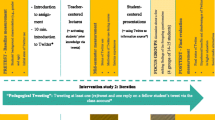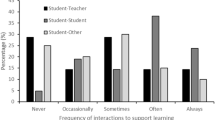Abstract
Social media’s reach has extended into our personal, professional, and educational lives. Related to the latter, research has examined how technologies, such as Twitter, can be used as communication and evaluation tools in postsecondary settings. No known studies have considered students’ experiences using Twitter in different course delivery formats (e.g., on campus compared to online courses), yet this can inform instructor decision-making on whether Twitter can be more effectively incorporated as an instructional tool in one format over another. This study sets out to examine whether differences existed between students’ perceptions and use of this social media platform as a device for learning and “classroom” connectedness. As students’ perceptions can reveal the effectiveness of pedagogical strategies given their position at the center of the learning process, the present study relied on anonymous, voluntary online survey results from 37 students enrolled in an upper-level Sociology of Deviance course delivered by the same instructor both online and on campus to ascertain students’ use of Twitter and their perceptions of using Twitter in learning, as a course evaluation tool, and in connecting students. Our findings suggest there are interesting differences in the social networking platform’s use between the two course formats. These differences were used to recommend strategies for how instructors can integrate Twitter into their courses, both online and on campus.
Similar content being viewed by others
Notes
See Peters et al. (2018) for a description of Memorial University and the Department of Sociology.
This research did not require university ethics approval since the researchers used secondary anonymized data that resulted from a course evaluation.
References
Adams, B., Raes, A., Montrieux, H., & Schellens, T. (2018). “Pedagogical tweeting” in higher education: Boon or bane? International Journal of Educational Technology, 15(1), 19–35.
Beard, L. A., Harper, C., & Riley, G. (2004). Online versus on-campus instruction: Student attitudes & perceptions. Tech Trends, 48(6), 29–31.
Bista, K. (2014). Twitter in higher education: New pedagogy in the knowledge era of globalization. In M. Limbu & B. Gurung (Eds.), Emerging pedagogies in the networked knowledge society (pp. 195–205). Hershey: IGI Global Publications. https://doi.org/10.4018/978-1-4666-4757-2.ch010.
Borau, K., Ulrich, C., Feng, J., & Shen, R. (2009). Microblogging for language learning: Using Twitter to train communicative and cultural competence. In M. Spaniol, Q. Li, R. Klamma, & R.W.H. Lau (Eds.), Advances in web based learning – ICWL 2009 (pp. 78–87). https://doi.org/10.1007/978-3-642-03426-8_10.
Chawinga, W. D. (2017). Taking social media to a university classroom: Teaching and learning using twitter and blogs. International Journal of Educational Technology in Higher Education, 14(3), 3–22.
Chen, L., & Chen, T. L. (2012). Use of twitter for formative evaluation: Reflections on trainer and trainees’ experiences. British Journal of Educational Technology, 43(2), E49–E52. https://doi.org/10.1111/j.1467-8535.2011.01251.x.
Coates, H. (2007). A model of online and general campus-based student engagement. Assessment & Evaluation in Higher Education, 32(2), 121–141. https://doi.org/10.1080/0260293060080187.
Cohen, P. (1981). Student ratings of instruction and student achievement. A meta-analysis of multisection validity studies. Review of Educational Research, 51(3), 281–309.
d’Apollonia, S., & Abrami, P. C. (1997). Navigating student ratings of instruction. American Psychologist, 52(11), 1198–1208.
Diaz, D. P., & Cartnal, R. B. (1999). Students' learning styles in two classes: Online distance learning and equivalent on-campus. College Teaching, 47, 130–135. https://doi.org/10.1080/87567559909595802.
Dommett, E. J. (2018). Understanding student use of twitter and online forums in higher education. Education and Information Technologies. Advance online publication, 24, 325–343. https://doi.org/10.1007/s10639-018-9776-5.
Dunlap, J. C., & Lowenthal, P. R. (2009). Tweeting the night away: Using twitter to enhance social presence. Journal of Information Systems Education, 20(2), 129–136.
Dzvapatsva, G. P., Mitrovic, Z., & Dietrich, A. D. (2014). Use of social media platforms for improving academic performance at further education and training colleges. South African Journal of Information Management, 16(1).
Ebner, M., Lienhardt, C., Rohs, M., & Meyer, I. (2010). Microblogs in higher education: A chance to facilitate informal and process-oriented learning. Computers & Education, 55(1), 92–100.
Evans, C. (2014). Twitter for teaching: Can social media be used to enhance the process of learning? British Journal of Educational Technology, 45(5), 902–915. https://doi.org/10.1111/bjet.12099.
Forum Research. (2017). Number of twitter users in Canada from 2012 to 2021 (in millions). In Statista – The Statistics Portal. Retrieved from https://www.statista.com/statistics/303875/number-of-Twitter-users-canada/. Accessed 29 May 2018.
Freeman, S., Eddy, S. L., McDonough, M., Smith, M. K., Okoroafor, N., et al. (2014). Active learning increases student performance in science, engineering, and mathematics. PNAS, 111(23), 8410–8415. https://doi.org/10.1073/pnas.1319030111.
Friesen, N., & Lowe, S. (2011). The questionable promise of social media for education: Connective learning and the commercial imperative. Journal of Computer Assisted Learning, 28(3), 183–194.
Hamid, S., Waycott, J., Kurnia, S., & Chang, S. (2015). Understanding students' perceptions of the benefits of online social networking use for teaching and learning. The Internet and Higher Education, 26, 1–9.
Harris, H. S., & Martin, E. W. (2012). Student motivations for choosing online classes. International Journal for the Scholarship of Teaching and Learning, 6(2), 11.
Harrison, R., & Thomas, M. (2009). Identity in online communities: Social networking sites and language learning. International Journal of Emerging Technologies and Society, 7(2), 109–124.
Hitchcock, L. I., & Young, J. A. (2016). Tweet, tweet!: Using live twitter chats in social work education. Social Work Education, 35(4), 457–468. https://doi.org/10.1080/02615479.2015.1136273.
Hsu, Y., & Ching, Y. (2012). Mobile microblogging: Using twitter and mobile devices in an online course to promote learning in authentic contexts. The International Review of Research in Open and Distance Learning, 13(4), 211–227.
Java, A., Song, X., Finin, T., & Tseng, B. (2007). Why we Twitter: Understanding microblogging usage and communities. Paper presented at the Proceedings of the 9th WebKDD and 1st SNA-KDD 2007 Workshop on Web Mining and Social Network, Analysis, pp. 56–65.
Jones, A. (2015). How Twitter saved my literature class: A case study with discussion. In C. Wankel, M. Marovich, K. Miller, & J. Stanaityte (Eds.), Teaching arts and science with the new social media (pp. 91–105). Bingley: Emerald Group Publishing.
Junco, R., Heiberger, G., & Loken, E. (2011). The effect of twitter on college student engagement and grades. Journal of Computer Assisted Learning, 27(2), 119–132. https://doi.org/10.1111/j.1365-2729.2010.00387.x.
Junco, R., Elavsky, M., & Heiberger, G. (2013). Putting twitter to the test: Assessing outcomes for student collaboration, engagement and success. British Journal of Educational Technology, 44(2), 273–287. https://doi.org/10.1111/j.1467-8535.2012.01284.x.
Kuh, G. D. (2001). The national survey of student engagement: Conceptual framework and overview of psychometric properties. Bloomington: Indiana University Center for Postsecondary Research and Planning.
Lyke, J., & Frank, M. (2012). Comparison of student learning outcomes in online and traditional classroom environments in a psychology course. Journal of Instructional Psychology, 3(4), 245–250.
Madge, C., Meek, J., Wellens, J., & Hooley, T. (2009). Facebook, social integration and informal learning at university: It is more for socialising and talking to friends about work than for actually doing work. Learning, Media and Technology, 34(2), 141–155. https://doi.org/10.1080/17439880902923606.
Menkhoff, T., Chay, Y. W., Bengtsson, M. L., Woodard, C. J., & Gan, B. (2015). Incorporating microblogging (“tweeting”) in higher education: Lessons learnt in a knowledge management course. Computers in Human Behavior, 51(B), 1295–1302.
Ni, A. Y. (2013). Comparing the effectiveness of classroom and online learning: Teaching research methods. Journal of Public Affairs Education, 19(2), 199–215.
Peters, A. M. F., Costello, J., & Crane, D. (2018). Deviating from the traditional instructional tools: Integrating Twitter in a sociology of deviance course. Canadian Journal of Learning and Technology, 44(3). https://doi.org/10.21432/cjlt27792.
Robinson, C. C., & Hullinger, H. (2008). New benchmarks in higher education: Student engagement in online learning. Journal of Education for Business, 84(2), 101–109. https://doi.org/10.3200/JOEB.84.2.101-109.
Rohr, L. E. & Costello, J. (2015). The use of Twitter as an assessment tool in a large enrollment online course. Online Learning: Official Journal of the Online Learning Consortium: Invited Papers/OLC 20th Anniversary Conference Special Issue, 19(4), 25-36.
Rohr, L. E., Costello, J., & Hawkins, T. (2015). Design considerations for integrating Twitter into an online course. International Review of Research in Open and Distributed Learning, 16(4), 241-249. https://doi.org/10.19173/irrodl.v16i4.2376.
Shuell, T. J., & Farber, S. L. (2001). Students’ perceptions of technology use in college courses. Journal of Educational Computing Research, 24(2), 119–138.
Smith, T., & Lambert, R. (2014). A systematic review investigating the use of twitter and Facebook in university-based healthcare education. Health Education, 114(5), 347–366. https://doi.org/10.1108/HE-07-2013-0030.
Tang, Y., & Hew, K. F. (2017). Using twitter for education: Beneficial or simply a waste of time? Computers & Education, 106(2017), 97–118.
Thoms, B., & Eryilmaz, E. (2015). Introducing a twitter discussion board to support learning in online and blended learning environments. Education and Information Technologies, 20(2), 265–283. https://doi.org/10.1007/s10639-013-9279-3.
Voorn, R. J. J., & Kommers, P. A. M. (2013). Social media and higher education: Introversion and collaborative learning from the student’s perspective. International Journal of Social Media and Interactive Learning Environments, 1(1), 59–73.
Wakefield, J. S., Warren, S. J., & Alsobrook, M. (2011). Learning and teaching as communicative actions: A mixed-methods twitter study. Knowledge Management & E-Learning: An International Journal, 3(4), 563–584.
Welch, B. K., & Bonnan-White, J. (2012). Twittering to increase student engagement in the university classroom. Knowledge Management & E-Learning: An International Journal, 4(3), 325–345.
Woo, Y., & Reeves, T. (2008). Interaction in asynchronous web-based learning environments: Strategies supported by educational research. Journal of Asynchronous Learning Networks, 12(3–4), 179–194.
Author information
Authors and Affiliations
Corresponding author
Additional information
Publisher’s note
Springer Nature remains neutral with regard to jurisdictional claims in published maps and institutional affiliations.
Rights and permissions
About this article
Cite this article
Peters, A.M.F., Crane, D. & Costello, J. A comparison of students’ twitter use in a postsecondary course delivered on campus and online. Educ Inf Technol 24, 2567–2584 (2019). https://doi.org/10.1007/s10639-019-09888-1
Received:
Accepted:
Published:
Issue Date:
DOI: https://doi.org/10.1007/s10639-019-09888-1




